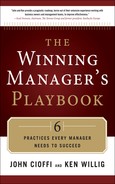An additional approach
And that’s what compelled us to look for an additional approach, one that takes less time but still provides you with the tools you need to adapt quickly to changes in your business and your environment. The notion is not to replace the traditional approach, at least not immediately, but rather to add another tool to the planning process so that you can retain the training value of the traditional approach while greatly increasing adaptability. This builds and strengthens your planning process on a regular basis, making it a habit within your company, while providing the flexibility to change plans in the face of changing conditions.
We concluded that there are four major categories of information that allow you to make quick and effective decisions and to create winning strategies—strategies to achieve success—in the face of changing conditions. The information is focused both inward on the company’s capabilities and outward on the company’s business environment. You’ll find details on each of these sections in Appendix B, but here they are:
- The strengths and deficiencies of your company.
- Industry forces—the favorable and unfavorable trends in your industry.
- Your competitive environment.
- Direct rivals.
- Imminent rivals.
- Substitutes for your products or services.
- Supplier pressure.
- Customer pressure.
- Your opportunities.
At first glance, these four major categories sound a bit like the traditional SWOT analysis (strengths, weaknesses, opportunities, and threats). And they do share some similarities. For example, they both consider your company’s internal strengths and weaknesses as well as its external opportunities and threats.
But we’ll coach you to look a bit deeper than that. For example, the favorable and unfavorable trends in your marketplace may not be an immediate threat or opportunity, and so might be ignored in a traditional SWOT analysis.
Surprisingly, Kodak did this in the early days of digital photography, when, despite its own patents for digital imaging, it stuck too long with its traditional film business while other firms raced ahead in digital photography. Some of these firms had no real experience in traditional film photography, but they knew how to make pixels dance, and they outpaced the company whose name had been synonymous with photography for many years.
Decades before, the Swiss did something similar when they ignored the inexpensive (though exceedingly accurate) quartz watch movements being sold by the Japanese. The Swiss simply didn’t see these cheap watches as a threat to their near-monopoly of high-end mechanical time pieces swathed in gold and jewels.
Similarly, a traditional SWOT analysis might not identify a threat or opportunity posed by an emerging change in a supplier relationship, because threats are most commonly viewed as actions taken by direct competitors and opportunities are most commonly viewed as movements in the marketplace. But a supplier can cause real joy or heartburn in a business.
For example, many manufacturing firms have long used suppliers that provide them with product components that arrive just in time (JIT), thus minimizing inventory costs. This requires a highly skilled supplier, but it can mean big savings for the manufacturer. So, when suppliers started to offer JIT inventory, savvy manufacturers seized it as a terrific opportunity. Those who didn’t cited numerous reasons as to why it wouldn’t work.
In effect, the four-category model here is meant to be a day-to-day assessment tool. Similar to the outline, it is a checklist, in this case a visual checklist, that reminds you of the key activities you must conduct to stay abreast of changing conditions. It compels you to think strategically on a regular basis, not just once in a while, and it allows you to create strategies that quickly adapt to your changing environment.
At this point, we’d coach you to ask yourself and your team this question on a regular basis, at least monthly:
What has changed in these four categories?
When you can answer that question quickly, accurately, and on a regular basis, you’ll have taken the first important step to creating a robust and flexible planning process.
